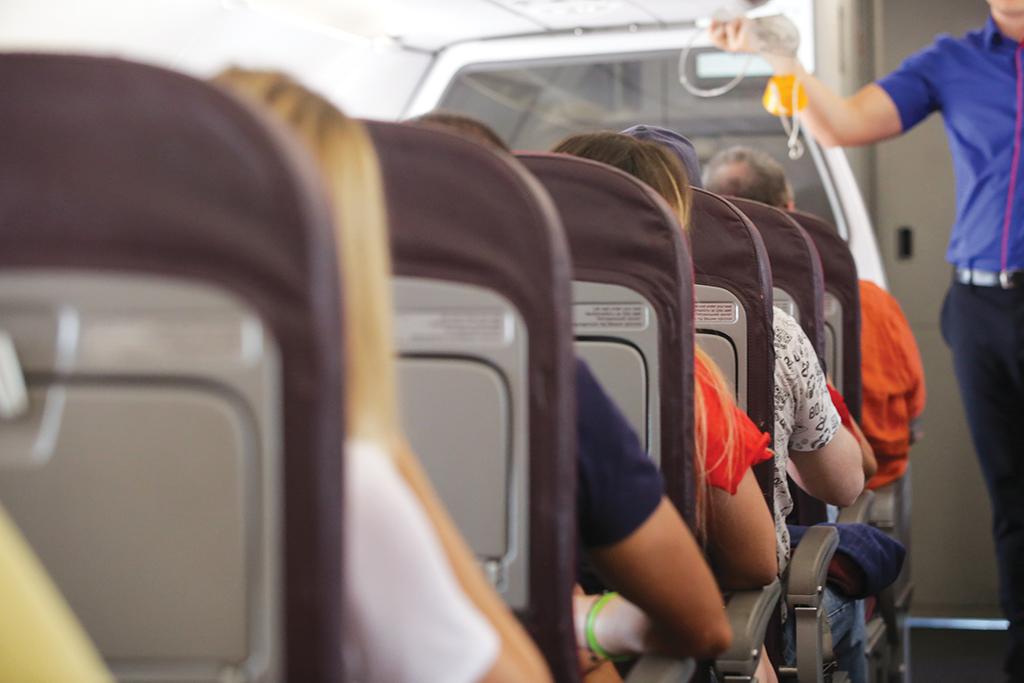
A Texas-based company has identified aircraft boarding doors as a vacant spot in the effort to help prevent viruses from spreading during air travel and plans to fill the gap with a system that automatically scans people for signs of a fever as they step onboard.
The premise is straightforward: The system, christened Nightingale, uses infrared cameras mounted inside aircraft doors to screen passengers, flight crew and anyone else who walks onboard for elevated body temperature (EBT). When the defined temperature range is exceeded, a signal such as a red light is triggered. The operator determines the next step based on the protocol in place, explains Kempen Cloete, founder of Cusi Aerospace.
- New system puts screening in airline’s control by adding hardware to aircraft
- Development fills a gap that currently relies on passive onboard tactics
- One large airline is interested in the system
Cloete and his team are developing the idea in response to the novel coronavirus pandemic that brought passenger air travel to its knees. But they see it as having staying power and becoming part of a layered approach both to ensure and reassure passengers and crew that they are not exposing themselves to elevated risk during certain types of global health crises.
The response to ensuring safety for travelers and workers in the current pandemic is evolving as a mix of different tactics. Some airports have rolled out temperature checks, and rapid testing for the COVID-19 illness is ramping up as well. On aircraft, new cabin-cleaning protocols have been introduced, adding to highly effective HEPA cabin filtration systems already in place.
Each tactic, while effective, has drawbacks. Testing protocols are location-specific—a passenger may be screened before one leg of a journey but not the next. Testing for COVID-19 is a useful but temporary measure—after this pandemic, it should no longer be needed. Measures taken onboard the aircraft are either invisible to passengers, such as the HEPA system, or passive, such as plastic barriers between seats.

“Passengers should feel safe in an aircraft cabin,” Embraer’s Asia-Pacific business development and contracts manager, Lais Port Antunes, said during a recent Aviation Week webinar. “But they need to see actions.”
Cusi is developing Nightingale with this in mind.
“This is only going to be solved by defense in depth” using varied approaches for detecting and preventing illnesses during the travel process, says Nick Olmstead, a product-certification expert working with CUSI on Nightingale’s supplemental type certification (STC). “It’s pretty clear to us that the missing link is something on an aircraft.”
Cloete acknowledges that temperature checks can do only so much. Although an elevated temperature may signal COVID-19 or a common cold, it is also a sign of many other viruses, making EBT screening a useful layer in any health response during an outbreak. Furthermore, putting the technology in the hands of aircraft operators allows them to provide consistency and certainty to customers without relying on external policies.
“Our system sends an alert of elevated temperature,” Cloete says. “It’s not a symptom checker. It applies a good, proven tool that allows aircraft operators to do something and provide a measure of control.”
Cusi’s plan calls for using Flir Systems A400/A700 series cameras, configured to read certain areas on a person’s face, preferably the canthus, or where the upper and lower eyelids meet. The system will look not for absolute temperatures but rather anomalies, says Chris Bainter, vice president of business development at Flir Systems. “Core body temperature can vary by person, time of day and many other factors,” he says. “You want a camera that can compensate its measurement based on the environment.”
The initial configuration puts an independent system at every door that passengers or aviation professionals—pilots, flight attendants, caterers, mechanics—could use. Each person is screened automatically, and the result is displayed and stored locally. A positive result could lead to secondary screening or other protocols, as determined by the operator.
“A pilot can pull a report anytime to look at what has happened since the previous cycle,” Cloete says. “Most new cleaning procedures are not being done in between flights. A report from our system can show potential cleaners, mechanics or others who accessed the aircraft and had elevated temperatures. Then it’s within the pilots’ capability to call for more extensive measures.”
Future versions will link each system together on a single aircraft and could be configured to transmit results remotely, such as to the ground or a central processing center. EBT screening could reinforce more complex strategies, such as using facial recognition to support contract tracing or ID verification at the aircraft that could help streamline boarding processes.
Several airlines have expressed interest in Nightingale, Cloete says, including one North American operator with a fleet of more than 100 aircraft. “They are very, very excited about what this can do for an airline,” Cloete says. “The fact that passengers actually see a system on the aircraft that scans people—they will know the person sitting next to them will have gone through the device.”
Customer interest will drive the STC development strategy, but the initial approvals are expected to be within the Airbus A320 and Boeing 737 families. Cusi is targeting initial approvals in the second quarter of 2021.
Cusi’s goal is to ensure installation occurs during overnight checks, one camera at a time. The aircraft can be dispatched following each installation, so an entire system can be put into place within a week, without adding any aircraft downtime, Olmstead says.
Cusi will pursue “approved model level” STCs, where the same baseline data is certified for installation on multiple aircraft models, Olmstead says. “This is about as simple a system as you can get,” he says. “The brains are in the camera.”



Comments
Seems to me having to turn around passengers right at the door of the aircraft (especially after transiting the jetway) would cause quite the traffic jam, and bring people into even closer proximity.